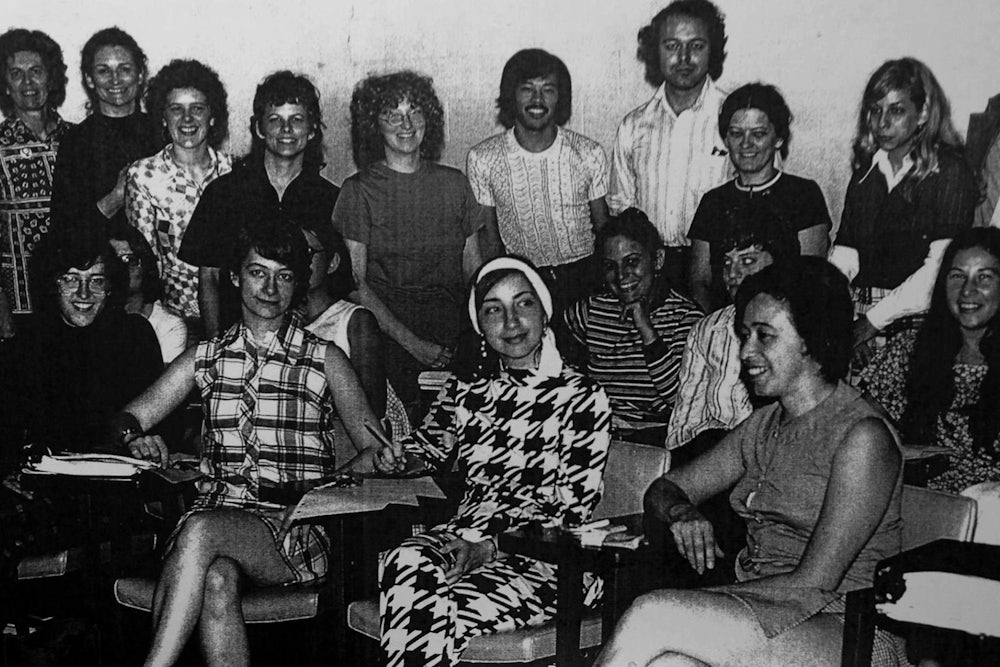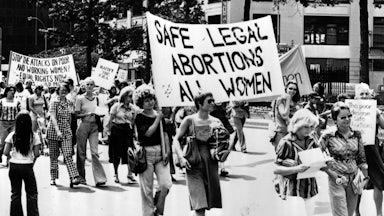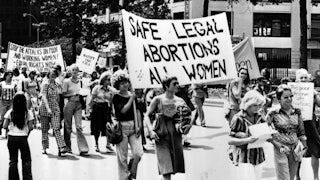When Heather Booth helped a friend’s sister obtain an abortion in 1965, she thought it would be a one-off situation. Instead, it became the start of a legendary underground operation known as the Jane Collective, or simply Jane. In the years leading up to the 1973 Roe v. Wade decision, the Jane Collective helped thousands of pregnant people in the Chicago area and beyond obtain abortions in defiance of strict statewide bans—establishing procedures to protect and support those seeking them and those providing them, and also to promote safety.
Now, following Texas’s law to ban abortions after six weeks (before many people know they are pregnant) and award private citizens $10,000 for suing anyone remotely involved in a procedure beyond those weeks, the right to an abortion, already something that existed more in theory than reality for much of the country, seems ever more uncertain. Many activists are turning to earlier generations for lessons on how to resist restrictions and get care to those who need it. I called up Booth to ask her about Jane’s history and her perspective on the new law.
This interview has been edited for clarity and length.
When Roe v. Wade was decided, did you think that era of illegal abortion was gone for good?
What I felt was relief that women would now have the freedom to decide when or whether to have a child. And I was relieved for all the women who would otherwise have been affected by laws that were hostile to women, and hostile to women having full participation in society. I was also relieved because there were seven women who had been arrested for working on Jane, and once Roe was decided the charges were dropped and the case became moot. So mostly I felt relief. There also was some concern about the medicalization of abortion: We knew that Jane was providing such quality care and support for the women, and such quality of care in the procedure, and we wanted to make sure that that continued.
Do you see the pre-Roe era returning?
When abortion was criminalized before 1973, three people talking about arranging for an abortion was treated, in Chicago, where I was, as a conspiracy to commit a felony. And we’re now going back to those days.
But now in some ways it’s worse: It’s become a partisan political issue—which it was not really in 1973—because the Republican Party in particular decided that this is the way to win votes and build a base in part among evangelicals. The opposition to abortion is much more intense now, and much more vicious and vindictive to all people involved—those who are seeking the procedure for themselves, or people who care about those seeking the procedure, family, friends, supporters, people in the medical profession, and others.
What’s passed in Texas is a vigilante law that even goes beyond the partisan support. It is encouraging people to inform on each other. It’s pushing society toward something like life under an authoritarian government, where you don’t know if you can trust your neighbor or relative or friend or your driver. And it leads to a society based on distrust and paranoia—not even paranoia, because paranoia is a word for when you fear something and it’s unwarranted, and this fear is warranted.
How did you first start helping pregnant people obtain abortions?
The origins of Jane really begin with the civil rights movement. I had been involved with Congress of Racial Equality, around support for the sit-ins at Woolworth, which wouldn’t let African Americans sit at their lunch counters in the South. We went to Mississippi in 1964 and saw the incredible courage of Black people in the South who were being denied the right to vote, and I learned several key lessons from that. One was that if you organize, you can actually make enormous change. But you have to take action—it doesn’t happen on its own. The second lesson was that you sometimes need to stand up to illegitimate authority. In the 1964 summer project, we were involved in what should have been a routine registration effort—all we were doing was encouraging people to register—and a short while later I was in jail. And the third big lesson that I learned was that people know what they need and want, and you need to listen to local people.
Those three lessons guided what followed. Once I had returned to campus, a friend mentioned that his sister was pregnant and was nearly suicidal and was not prepared to have a child, and asked whether I could find someone to provide an abortion for her. I hadn’t really thought about the issue before, but I went to the Medical Committee for Human Rights, and I found a doctor, T.R.M. Howard. (I learned later he had been a leader in the civil rights movement in Mississippi.) And I talked to him about my friend, put him in touch with her, and I thought that would be the end of it. But she must have spoken to others because a short while later someone else called. And then someone else called. And at that point, I realized as an organizer I should find out what’s involved in these procedures. So I found out medically what’s involved, what you do to protect yourself, what the cost is, etc. We negotiated on price—whether it could be lowered to two for the price of one, three for the price of one, because more and more people were then coming.
After a while we lost contact with Dr. Howard, so I found someone whose name was Mike. We set up the same operation that I had with Dr. Howard. By 1968, I was pregnant with my first child, and I was in grad school and working full-time and involved in other movement work, and there were too many people coming through. I couldn’t handle it myself. So I went to meetings and would say at the end, if there’s anyone who wants to work on abortion come see me. And when I had about 12 or so people, I convened a series of meetings, told them what was involved in the procedure, and we did role-playing on counseling and supporting the women who were coming through, and how to connect with Mike (through an associate of his), and I passed the operation over to a larger set of women. Over time that set of women grew to about 100.
They eventually found out that Mike wasn’t a physician, wasn’t a licensed M.D., and yet the procedures had been safe. (In fact, after Roe, one of the women who was working in a health research effort at the University of Illinois, did an analysis of the successful outcomes, comparing Jane to a licensed facility after Roe, and found that Jane had an even higher rate of safety and success and support.) So the women who were involved with Jane decided, well, if he can do it, they can do it. And Mike, to his credit, taught them how to do the procedures. And that continued so that about 11,000 women went through Jane, with the women themselves performing the procedures.
When the police raided in 1972, this man burst into the room and said, “Where is he? Where is he?”—“he” being the doctor. And of course there was no man there, only women, and they arrested the women involved in Jane, still thinking it was someone else doing the procedures. No one would testify against the women. And then when Roe became the law of the land, the cases were dropped.
What is different this time around?
There are many things that have changed in a positive way since Roe. For one thing, there are now many providers who have learned how to do the procedure. They’re experienced, they’re capable and able to provide support. The pills you can take for a self-induced abortion are another huge change. There’s the National Abortion Federation, which is a support center for clinics that provide this care. There’s legal help. There’s a history of case law nationally and in states. And there are now thousands, rather than hundreds, of activists involved in the caring, protection, and support for women’s health. So the expansion of what was an underground then, and the expansion of services—from Texas, even now, you can get transportation, funding, housing, medical care, you can be referred to options elsewhere—is a big change.
On the negative side, there’s this partisanship around the issue, and the amount of money that’s being poured into the opposition. And then there’s the whole idea of placing a bounty on the heads of anyone who helps—rewarding people who turn in others who are seeking help for someone who needs an abortion after six weeks, after a period of time in which someone may not even know they’re pregnant. Before they can know what the health implications for them personally might be.
This bounty creates a police-state kind of mentality. And that really is taking this to another level. It was designed for what Texas’s right-wing lawmakers believed was needed to pass muster on Roe; they believed that the court was telling them, don’t have the state enforce this. So if the state’s not enforcing it then the next step was to enforce it by having neighbor report on neighbor. And that’s actually the worst aspect—state-sponsored distrust. State-sponsored destruction of community.
Another thing to consider is that corporations are giving money to these legislators, even as they try to make a name for themselves saying they are advocates for health care or advocates for women’s rights. AT&T is one of the corporations, according to a newsletter, Popular Information, that tracked how corporate money is backing the opposite of what the corporations say they want to do.
What lessons do you think current activists can take from your early work on this issue?
I think many things are needed. Jane was a service. And it was a service that ended up being most important for people who couldn’t travel out of state or internationally to obtain abortions. We do need to expand services. But what we really need to do is build the political power to stop these abusive laws. And that will take organizing, building political and electoral power. It will take legal support. It will take visibility and cultural action. It will take people speaking out, broader education, informing people more about what their options are. And also it means providing people information about contraceptives, medically accurate information about birth control and reproduction. And support for women having full participation in society.
What’s your biggest worry about how the changes underway in Texas are going to play out in the coming weeks, months, and years?
It all depends on what we do: if we organize and how skillful we are. Are we talking only to those already involved, or are we reaching out to those who don’t understand the consequences yet, who don’t know that they can have an impact? People need to learn that change for the better happens when we organize. We need to organize.
There are a wide array of organizations for people to participate in. There is a demonstration being called for October 2, and I’m sure there’ll be a lot more visibility around it. I think there will be interest from grassroots groups and health care groups and women’s groups and faith organizations and community and social action organizations. We all need to come together on it, both to organize power to support people who are making these decisions about their lives and also to convert it to political power so that we overcome the Republican gerrymandering—essentially new Jim Crow laws that are depressing votes—and can move toward small-d democracy and justice for all.








